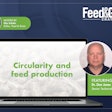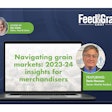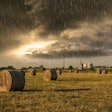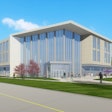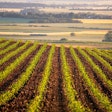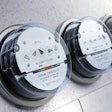Elise Schafer, editor of Feed & Grain:Hi, everyone, and welcome toFeed & Grain Chat. I'm your host, Elise Schafer, editor of Feed & Grain. This edition of Feed & Grain Chat is brought to you by WATT Global Media, andfeedandgrain.com. Feedandgrain.com is your source for the latest news, product and equipment information for the grain handling and feed manufacturing industries.
Today, I'm joined on Zoom by Terry Medemblik, president of WALINGA, a leading supplier of bulk feed bodies and other engineered transportation equipment. He's here today to discuss the environmental benefits of their new electric feed trailer.
Hi, Terry, welcome to Feed & Grain Chat!
Terry Medemblik, president of WALINGA:Good morning, Elise. It's good to be here. Nice to see you again after theunveiling of our traileratIPPE.
Schafer:是的,这是一个激动人心的事件!谢谢你的发票iting us. Now let's get right into it. How did WALINGA’s customers help inspire the idea of an electric feed trailer?
Medemblik:I think it's safe to say we do our utmost to listen to our customers and what our customers’ needs and wants are. And over the last several years, the term sustainability has really become a big factor in feed manufacturing, feed production, of whichfeed transportationdefinitely is a part of that equation.
Being a member of the Equipment Manufacturers’ Committee as a part of theAFIAhas given us as a company an opportunity to keep our proverbial ears to the track as far as what are our customers' needs. And one of the biggest things that's been coming through, the loudest message that's coming through has been sustainability. And a part of that sustainability, if we then take that and look at feed transportation equipment, what can we do as a manufacturer to help our customers achieve a higher level of sustainability?
Feed transportation has become a very important link in the whole spectrum of feed manufacturing as feed / food supply to the general public, so I think the biggest thing was knowing how can we then rethink the feed trailer in order to gain some sustainability issues. And that was basically the message that we were getting and that's what caused us to sit down, especially the last year or two years, to figure out what can we do.
Schafer:So what features of the traditional trailer were reconfigured for the EVolution electric trailer and does that change how it’s operated?
Medemblik:The standard or the typical feed trailer is hydraulically powered. You have hydraulic motors running your augers, you have hydraulic cylinders lifting your booms, you have hydraulic motors, turning your vertical augers for positioning, you have manual gates or air operated gates, so we took all of that and went 100% electric on all controls. So, the functionality of it remains [the same] — you're flipping switches, or you're pushing buttons, but we've taken completely out of the picture all hydraulics.
Schafer:What are the main advantages of an electric feed trailer versus conventional trailers?
Medemblik:I think the main advantage of the electric operated trailer — and there are going to be other challenges and because this is a very new innovation for the feed industry, I don't think we understand it 100%. I think we have a healthy understanding of what the challenges are that we're going to be faced with coming forward as we continue to vet this unit, to make it ready, commercially available for the feed industry, but one of the biggest things we're finding with the electric aspect are the increased advantages especially with respect to efficiency.
We've changed the air gates. We've gone to electric gates, we've gone to electric roof lid opening, electric handrails, plus, of course, all the electric motors for the drive factor. Electric gates, for instance, when we're using our HMI, our Human Machine Interface control packages on our trailers that we developed eight years ago on our hydraulic controls, which has come very far in today's control packages even on hydraulic trailers, to be able to utilize that on the electric side of it, we can get a lot better operating efficiencies out of the trailer.
One of the things you're going to be able to see then is pre-set parameters for operations. So, the level of capability of drivers, for instance, a challenge that feed companies are faced with every day is finding drivers who have the ability to run a feed trailer. It sounds simple at first, but when you really get into it, it gets to be more challenging. And especially as feed companies are looking for efficiencies to be gained, you take a high output auger discharge system that all feed truck manufacturers produce, your margin of error on a feed trailer like that isvery tight. Meaning that a driver can screw it up pretty quickly and he doesn't have to try hard to do it.
So, if we can take all those issues away and pre-program a trailer to be able to do certain things, the level of expertise of the driver can come down and you can still retain those efficiencies in operations. That's really one of the bigger driving factors behind it, as well. The two primary ones is the environmental issues and then the efficiencies that operators are going to hopefully receive and see come out of this piece of equipment.
And I guess this is where part of the environmental issue comes from when you're running hydraulics on equipment, there's going to be waste. Your hydraulic oil only lasts for so long, and you have to dispose of it. And depending on your system, it could be anywhere from 20, 30 gallons, up to 50, 60, 70 gallons of oil that you're replenishing on a very regular basis. The other side of it is also the environmental impact of waste oil when you have an oil spill on the farm. And that that was one of the comments that were coming back from some of our customers and knowing that they have a pretty sizable budget for dealing with waste oil or with environmental spills. If we can eliminate the oil issue, then we can help with that aspect of it. So, utilizing electrical components has allowed us to get away from that for obvious reasons.
But the other thing is with hydraulics — I know somebody's probably going to challenge me on this — but let's say for discussion purposes, hydraulics are roughly 85% efficient. When you put hydraulic pressure to a motor, there's slippage, so that slippage translates into inefficiency. Hydraulic motors are typically around 85% efficient, whereas electric is 100%. When you flip a switch on electric, it's going. Your electric motors have a higher level of efficiency, you eliminate heat issues because with hydraulics with inefficiency, you have heat build-up. With electric, you're not going to have that.
The other aspect of it was the controllability of the trailer. With electronics, we end up with a much higher level of controllability, information feedback, which lends itself then into the ability to provide better control packages for the trailers.
The feed trailer of today is not your grandpa's feed trailer of yesteryear. Feed transportation plays a very critical role in the whole aspect of Safe Feed/Safe Food, for instance. And if you've got everything here in the mill is right and you've got everything over here in the poultry house is right, but your in-between — which is your transportation — is wrong, all this here on these two sides is for naught. So, as feed transportation manufacturers, we see the necessity to really step this up to have a healthier understanding of what the needs for our customers are, and meet them head on. And be that supplier that's going to come with the right choices and the right options for our customers.
Schafer:Well said, Terry, great summary. Do you have a timeline for this new innovation to become commercially available to the feed sector?
Medemblik:我们走这条路很多年前a customer overseas, and basically what they wanted was to be able to pull the trailer with any piece of equipment, not having to be dedicated to the tractor. So, the power supply had to come from somewhere else. So basically, what we did was we utilized the power supply — electric — at the farm site where they were unloading, but basically the trailer had an extension cord that the driver pulled up to the building, plugged into the building, and was able to maneuver the trailer somewhat to unload the trailer utilizing the power at the facility.
Of course, that's very restrictive, so understanding that and seeing that growth from several years back to two years ago, when we sat down and said we’ve got to do something with this, to last year saying "Okay, if we're going to do this, we want to unveil that IPPE 2023." So, all the work went into it, now the vetting process has to continue on, making sure that the components we've chosen are going to fit within the operating parameters that we need and doing some what we're going to call dry testing and wet testing. Once we’ve got that done, we’re probably looking at several months of bringing it around to customers, letting them try it out, find out what's wrong with it, what's good with it, what's not so good with it, and the intention then, long story short, is we're hoping that in 2024 we're ready to hit the market with this.
Schafer:Well, thank you for the update, Terry, and your insights on the development of this innovative product.
Medemblik:You're very welcome.
Schafer:That's all for today's Feed & Grain Chat. If you'd like to see more videos like this, subscribe to ourYouTubechannel,sign up for the Industry Watch daily eNewsletter, or go to feedandgrain.com andsearch for videos. Thank you again for joining, and we hope to see you next time!
Feed transportation equipment is no longer viewed as the "necessary evil" it once was, but rather an important link in the spectrum of feed production, according to Terry Medemblik, president ofWALINGA. As such, it can also be a significant part of the solution to reducing the overall environmental impact of animal food manufacturing.
Medemblik stopped by Feed & Grain Chat to share how WALINGA is taking steps closer to sustainable feed transportation by replacing hydraulics with electricity in its newest innovation — theEVolutionelectric-operated feed trailer.













